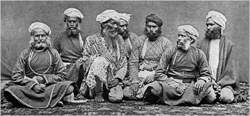
Back ঠগি Bengali/Bangla Thuggee Catalan Thugové Czech Thuggee Danish Thuggee German Los Estranguladores Spanish Itotzaileak Basque Tugeenit Finnish Thug French Thuggee Galician
 Group of Thugs around 1894 | |
| Founded | unknown, possibly early 1300s[1] |
|---|---|
| Named after | Sanskrit word for concealment |
| Founding location | Central India and Bengal |
| Years active | c. 14th century – late 19th century |
| Territory | Indian subcontinent |
| Membership | Unknown |
| Activities | Murder, robbery |
| Rivals | British Raj, merchants |
Thuggee (UK: /θʌˈɡiː/, US: /ˈθʌɡi/) is the name given to the alleged practice of thugs, who, supposedly, were historical organised cults of professional robbers and murderers in India. They were said to have travelled in groups across the Indian subcontinent.[2]
They are purported to have murdered their victims by strangling using a bandana as a tool.[3] The Thuggee were believed to practise their killings as a form of worship toward the goddess Kali.[4] For centuries, the authorities of the Indian subcontinent, such as the Khalji dynasty,[5] the Mughal Empire,[1] and the British Raj, attempted to curtail the criminal activities of the Thuggee during their rule.[6]
Contemporary scholarship is increasingly sceptical of the thuggee concept, and has questioned the existence of such a phenomenon,[7][8] which has led many historians to describe thuggee as the invention of the British colonial regime.[9]
- ^ a b Wagner 2007, p. 26.
- ^ "Tracing India's cult of Thugs". 3 August 2003. Los Angeles Times.
- ^ Cite error: The named reference
David Scott Katsan 2006 141was invoked but never defined (see the help page). - ^ Cite error: The named reference
Will Sweetman, Aditya Malikwas invoked but never defined (see the help page). - ^ Cite error: The named reference
Martine van Woerkens 2002 110was invoked but never defined (see the help page). - ^ Wagner 2007, p. 7.
- ^ Gámez-Fernández, Cristina M.; Dwivedi, Om P. (2014). Tabish Khair: Critical Perspectives. Cambridge Scholars Publishing. ISBN 9781443857888.
- ^ Cite error: The named reference
ReferenceAwas invoked but never defined (see the help page). - ^ S. Shankar (2001). Textual Traffic: Colonialism, Modernity, and the Economy of the Text. SUNY Press. ISBN 978-0791449929.